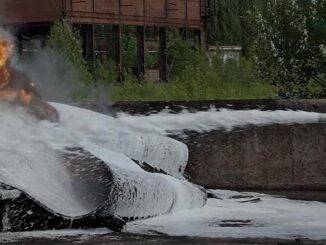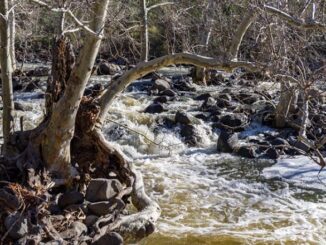TOPEKA, Kansas, September 22, 2021 (ENS) – The Kansas Department of Health and Environment and the Kansas Department of Wildlife and Parks have issued two dozen public health advisories for Kansas lakes due to the presence of harmful bluegreen algae.
Milford Lake Zones B and C are on Warning level due to very high toxin levels in samples collected on August 30. These toxins can be absorbed by ingestion, inhalation of aerosols and through skin contact.
If people observe a scum or paint-like surface on the water, small floating blue-green clumps or filaments in the water, or if the water is an opaque green, they should avoid contact and keep pets away. The Kansas agencies say that these signs are indications that a harmful bloom may be present.
Pet owners should be aware that animals that swim in or drink water affected by a harmful algal bloom or eat dried algae along the shore may become seriously ill or die.
Children and dogs are more susceptible to toxin exposure than adults. Blue-green algae blooms are unpredictable, and conditions can change quickly. All lake visitors should use caution and remain vigilant. The Milford State Park Splash Pad offers a safe recreation option for lake visitors throughout the season.
Active Advisories
Warnings are in effect for:
Altamont City Lake “Idle Hour” – North Lake, Labette County
Colwich City Lake, Sedgwick County
Gathering Pond at Milford, Geary County
Harvey County East Lake, Harvey County
Jerry Ivey Pond, Saline County
Lake Afton, Sedgwick County
Marion County Lake, Marion County
Marion Reservoir, Marion County
Melvern Outlet Pond, Osage County
Melvern Outlet Swim Pond, Osage County
Milford Lake Zones A, B and C, Geary/Dickinson/Clay Counties
Neosho Co SFL, Neosho County
Riverwalk Landing Pond, Geary County (elevated Sept. 16)
South Lake, Johnson County
A Warning status indicates that conditions are unsafe for human and pet exposure. Contact with the waterbody should be avoided.
When a warning is issued:
• Lake water is not safe to drink for pets or livestock.
• Lake water, regardless of blue-green algae status, should never be consumed by humans.
• Water contact should be avoided.
• Fish may be eaten if they are rinsed with clean water and only the fillet portion is consumed, while all other parts are discarded.
• Do not allow pets to eat dried algae.
• If lake water contacts skin, wash with clean water as soon as possible.
• Avoid areas of visible algae accumulation.
Watch:
Altamont City Lake “Idle Hour” – Main Lake, Labette County
Big Eleven Lake, Wyandotte County
Cheney Lake, Reno County (new)
Ford County Lake, Ford County
Hodgeman Co SFL, Hodgeman County (lowered Sept. 16)
Protect and Improve the Health and Environment of all Kansans
Lake Jeanette, Leavenworth County
Pony Creek Lake, Brown County
Webster Reservoir, Rooks County
Advisories were lifted on September 16 for:
Buhler City Lake, Reno County
Roses Lake, Johnson County
A Watch status means that blue-green algae have been detected and a harmful algal bloom is present or
likely to develop. People are encouraged to avoid areas of algae accumulation and keep pets and livestock
away from the water.
During the watch status:
• Signage will be posted at all public access locations.
• Water may be unsafe for humans/animals.
• Avoid areas of algae accumulation and do not let people/pets eat dried algae or drink
contaminated water.
• Swimming, wading, skiing and jet skiing are discouraged near visible blooms.
• Boating and fishing are safe. However, inhalation of the spray may affect some individuals. Avoid
direct contact with water, and wash with clean water after any contact.
• Clean fish well with potable water and eat fillet portion only.
The Kansas Department of Health and Environment investigates publicly-accessible bodies of water for blue-green algae when the agency receives reports of potential algae blooms in Kansas lakes. For information on blue-green algae and reporting potential harmful algal blooms, please click here.
Farmers Can Get Help Dealing With Blue-Green Algae
Kansas State University specialists and local extension agents are providing timely information to help the state’s farmers understand the risks of blue-green algae in farm ponds and other watering sources.
Blue-green algae is a cyanobacteria, or bacteria that lives off the sun. It is toxic to livestock, dogs and people. During periods of extreme heat and sunshine, blooms of cyanobacteria can build up in a pond and form into distinct blooms of bacteria, often looking like paint sliming around in the water. The paint-like texture of cyanobacteria is what differentiates it from non-harmful moss in a pond.
The harmful cyanobacteria can look green or dark green, but can turn more to a bluish tint, thus leading to its more common name as blue-green algae.
Extension professionals across Kansas are alerting producers to the dangers of blue-green algae and how to prevent harm to animals and people, including fencing off the area and avoiding the use of water from that portion of the pond or water source.
Kansas State University offers analysis of water samples through the Veterinary Diagnostic Lab to help landowners quickly determine if a water source is affected by blue green algae. More information is available at http://www.ksvdl.org or by calling 866-512-5650.
Featured image: Blue-green algae on a Kansas lake. (Photo courtesy Kansas State University)



